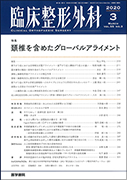文献詳細
特集 頚椎を含めたグローバルアライメント
文献概要
歴史的には,グローバルアライメントに関する研究は胸腰椎で先行し,近年,骨盤下肢を含めて評価することが体系づけられたが,頚椎を含めたグローバルアライメントは未解明の部分が多い.真の重心線は外耳道付近から下ろした垂線であることから,頭蓋と頚椎を含めてグローバルアライメントを解析することが重要である.本稿では頚椎を含めたグローバルアライメントの基本事項を概説する.
参考文献
1) 水谷 潤.頚椎後弯症に対する変形矯正固定術.特集 頚椎固定法の進歩.整・災外2015;58(4):449-57.
2) Dubousset J. Three-dimensional analysis of the scoliotic deformity. In:Weinstein SL (ed). The Pediatric Spine:Principles and Practice. New York:Raven Press, 1994.
3) Sugrue PA, McClendon J Jr, Smith TR, et al. Redefining global spinal balance:normative values of cranial center of mass from a prospective cohort of asymptomatic individuals. Spine 2013;38:484-9.
4) Schwab F, Ungar B, Blondel B, et al. Scoliosis Research Society-Schwab adult spinal deformity classification:a validation study. Spine 2012;37(12):1077-82.
5) Lee SH, Kim KT, Seo EM, et al. The influence of thoracic inlet alignment on the craniocervical sagittal balance in asymptomatic adults. J Spinal Disord Tech 2012;25:E41-7.
6) Ames CP, Blondel B, Scheer JK, et al. Cervical radiographical alignment:comprehensive assessment techniques and potential importance in cervical myelopathy. Spine (Phila Pa 1976) 2013;38(22 Suppl 1):S149-60.
7) Vital JM, Senegas J. Anatomical bases of the study of the constraints to which the cervical spine is subject in the sagittal plane. A study of the center of gravity of the head. Surgical and radiologic anatomy:Surg Radiol Anat 1986;8:169-73.
8) Hasegawa K, Okamoto M, Hatsushikano S, et al. Standing sagittal alignment of the whole axial skeleton with reference to the gravity line in humans. J Anat 2017;230:619-30.
9) Yagi M, Takeda K, Machida M, et al. Discordance of gravity line and C7PL in patient with adult spinal deformity-factors affecting the occiput-trunk sagittal discordance. The Spine J 2015;15:213-21.
10) Mizutani J, Verma K, Endo K, et al. Global spinal alignment in cervical kyphotic deformity:the importance of head position and thoraco-lumbar alignment in the compensatory mechanism. Neurosurgery 2018;82(5):686-694.
11) Mizutani J, Strom R, Abumi K, et al. How cervical reconstruction surgery affects global spinal alignment. Neurosurgery 2019;84(4):898-907.
掲載誌情報

